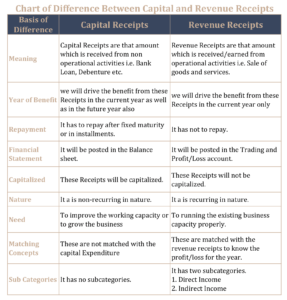To know the Difference Between capital and revenue receipts we have to know the meaning of both terms. and To know the meaning of Capital and Revenue Receipts, first of all, we have to know the meaning of the Receipts. Receipts meaning the amount received or will be received from operational and non-operational activities of the business. These can be paid in cash or credit or in kind. These are divided into two types on the basis of time. Explained as following: –
Meaning of Capital Receipts: –
Capital Receipts are that amount that is received from non-operational activities i.e. Bank Loan, Debenture, etc. In other words, the amount received from other than capital and operation for the explanation of business or for the running of the business is known as capital Receipts.
In short, we will drive the benefit from these Receipts in the current year as well as in the future year also.
Example: –
Taking a loan from the bank and issuing debenture to the public.
Meaning of Revenue Receipts: –
Revenue Receipts are the amount that is received/earned from operational activities i.e. Sale of goods and services. In other words, the amount received from other than Non-operation for the running of the business is known as Revenue Receipts.
Example: –
- Amount earned from the sale of goods and services
- Discount received
- Refund of taxes received
- Rent received from Building
- Sale of scrap
- Commission Received
- Income from other Sources, etc.
Chart of Difference Between capital and revenue receipts: –
Basis of Difference |
Capital Receipts |
Revenue Receipts |
|
Meaning |
Capital Receipts are that amount that is received from non-operational activities i.e. Bank Loan, Debenture, etc | Revenue Receipts are the amount that is received/earned from operational activities i.e. Sale of goods and services. |
|
Year of Benefit |
we will drive the benefit from these Receipts in the current year as well as in the future year also | we will drive the benefit from these Receipts in the current year only |
|
Repayment |
It has to repay after fixed maturity or in installments. | It has not to repay. |
|
Financial Statement |
It will be posted on the Balance sheet. | It will be posted in the Trading and Profit/Loss account. |
|
Capitalized |
These Receipts will be capitalized. | These Receipts will not be capitalized. |
|
Nature |
It is non-recurring in nature. | It is recurring in nature. |
|
Need |
To improve the working capacity or to grow the business | To running the existing business capacity properly. |
|
Matching Concepts |
These are not matched with the capital Expenditure | These are matched with the revenue receipts to know the profit/loss for the year. |
|
Sub Categories |
It has no subcategories. | It has two subcategories.
|
Download the chart: –
If you want to download the chart please download the following image and PDF file:-


The conclusion of Difference: –
The main difference in both types of Receipts is the repayment terms. The business has to repay capital receipts and has not to repay the revenue receipts.
Advertisement-X
Thanks for reading the topic
In the comment box, please write your feedback. whatever you want. If you have any questions please ask us by commenting.
Check out T.S. Grewal’s +1 Book 2019 @ Official Website of Sultan Chand Publication







Leave a Reply